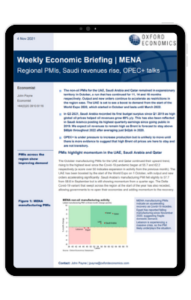MENA | Regional PMIs, Saudi revenues rise, OPEC+ talks

The non-oil PMIs for the UAE, Saudi Arabia and Qatar remained in expansionary territory in October, a run that has continued for 11, 14 and 16 months respectively. Output and new orders continue to accelerate as restrictions in the region ease. The UAE is set to see a boost to demand from the start of the World Expo 2020, which started in October and lasts until March 2022.
What you will learn:
- In Q3 2021, Saudi Arabia recorded its first budget surplus since Q1 2019 as high global oil prices helped oil revenues grow 60% y/y.
- This has also been reflected in Saudi Aramco posting its highest quarterly earnings since going public in
2019. - We expect oil revenues to remain high as Brent is forecast to stay above $60pb throughout 2022 after averaging just $42pb in 2020 OPEC+ is under pressure to increase production but is unlikely to move until there is more evidence to suggest that high Brent oil prices are here to stay and are not transitory.
Tags:
Related Services

Post
US Rolls Up Welcome Mat for International Travel
Research Briefing MENA | Regional PMIs, Saudi revenues rise, OPEC+ talks Trump tariffs set to raise effective rate above 1930s levels.
Find Out More
Post
Initial takeaways from Trump’s ‘Liberation Day’ announcement
In two or three years' time, US imports could fall by around 15% due to discounted reciprocal tariff hikes.
Find Out More